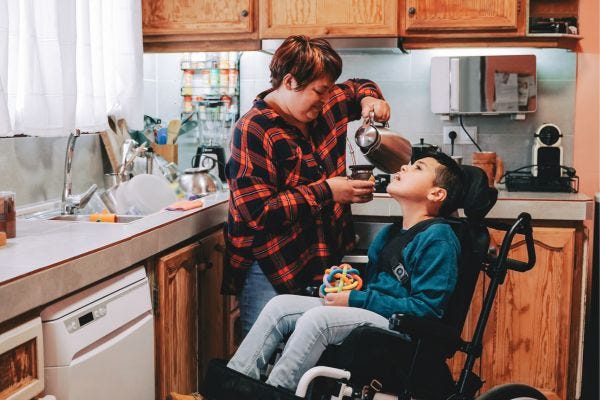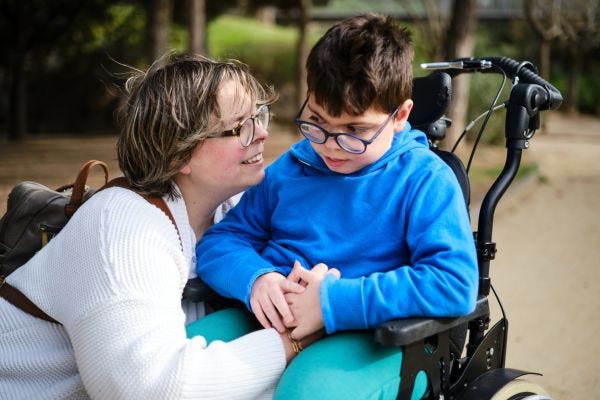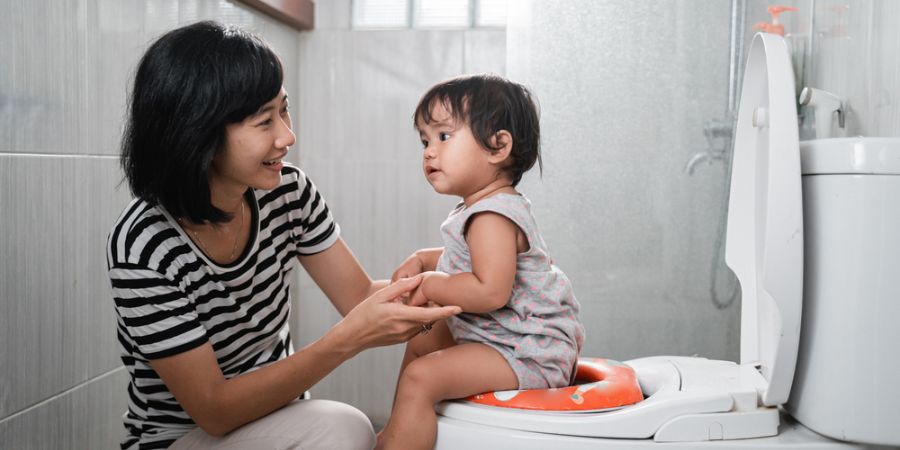Key Takeaways:
- Low-income families in the U.S. spend almost $1,000 annually on diapers, a burden worsened by rising living costs and even higher for caregivers of children with disabilities.
- Diaper need can lead to health issues and hinder children's ability to attend daycare or school, adding financial and emotional strain on families.
- Enhanced government assistance, policy changes, and community support are essential to help alleviate the diaper gap and support families in need.
In our society, the well-being and comfort of our little ones is commonly at the forefront of our minds.
However, for far too many children are not receiving proper care when it comes to their bladder and bowel control conditions. Caregivers of children-- especially those with disabilities-- are struggling to afford the diapers and pull-ups required to manage their loved ones' urinary and fecal leakage.
Check Your Child's Eligibility
In Less Than 2 Minutes
Discover the pediatric supplies covered by insurance.
From basic hygiene to emotional and physical health, the lack of access to essential products like diapers puts children at risk and lowers their quality of life.
These children and caregivers are living in the diaper gap-- a national health crisis that reaches every corner of the United States, and due to rising costs of living, high prices of diapers, and more factors, it is now more important than ever to aid all children and families who are struggling to afford incontinence products.
In this post, we’ll explain what the diaper gap is, explore why it’s crucial that low-income families with children have access to incontinence products, and tell you how to save money on incontinence supplies.
What Is the Diaper Gap?
The diaper gap is a national health crisis experienced by individuals of all ages with bladder and bowel control conditions, known as incontinence. Children and teens managing incontinence require certain products, like diapers, pull-ups, and training pants to control their leaks and live healthy lives. Those living in diaper need can’t afford to purchase incontinence products their loved ones require due to their high cost and inaccessibility.
Diaper need continues to worsen due to several factors:
- High cost of diapers. Diaper prices rose almost 9% during the Covid-19 pandemic.
- Failing government programs. While they are meant to help people in need, the Women, Infant, and Children (WIC) program and the Supplemental Nutrition Assistance Program (SNAP) don't allow people to purchase diapers or pull-ups.
- High cost of living. The cost of living increased after COVID-19, and it continues to rise.
- Poverty rates. Children under 5 years old are the most likely to live in poverty. In 2019, 6,554 families were living below the Federal Poverty Line (FPL).


Currently, 1 in 3 US families struggle to afford diapers for their loved ones.
The Cost of Disabilities
Around 3 million children in the US have disabilities. Disabilities that may cause incontinence include:
- Autism
- Down syndrome.
- Spina bifida
- Hirschprung's disease.
- Cerebral palsy.
Caregivers raising a child with a disability may face challenges, including paying out-of-pocket for incontinence products. Families spend around $240,000 raising children with disabilities to the age of 18, and caring for someone with a disability throughout their lifetime costs over $1.4 million. Since 23% to 86% of children with special needs experience incontinence, most caregivers likely spend a percentage of these high amounts on diapers, pull-ups, and other incontinence products necessary to allow their children to be happy and healthy. People with disabilities are also twice as likely to live in poverty compared to those without disabilities, and diaper costs put families that are not in poverty at an increased risk of falling below the poverty line.
Aside from spending thousands of dollars on diapers each year, other factors make it difficult for families with special needs children to afford diapers:
- Caregivers who stay home from work to provide around-the-clock care for their children lose income.
- High amounts of income are spent on medical care for special needs.
- Extra expenses, such as adaptive clothing, cost families extra money.
- General cost of living increases.


What Can Happen Without Diapers?
Because the main symptom of incontinence is unintentional leakage of urine or feces, going without diapers or pull-ups poses significant problems for children with and without incontinence. Some caregivers may resort to only changing their child when necessary to save diapers. This can lead to:
- Diaper rash. Diaper rash occurs when a diaper is not changed frequently enough due to moisture, waste, and bacteria irritating a child’s skin.
- Infection. Skin infection can occur when waste (fecal matter) enters an open sore.
- Urinary tract infection (UTI). A UTI occurs when harmful bacteria enter the urethra. An old diaper’s dirty and moist environment is the perfect breeding ground for these bacteria, increasing the risk for UTI.
Without diapers, children may also be unable to attend daycare or school, forcing a caregiver to stay home or pay for childcare, increasing their expenses. Parents or caregivers may also develop stress, shame, and even depression if they cannot provide diapers for their children.
The consequences of not having incontinence products may be even more significant for children with special needs. Urinary and fecal incontinence are common among children with disabilities. The conditions can occur for many reasons, including:
- Inability to interpret bodily signals.
- Nerve damage.
- Cognitive impairment.
- Communication issues.
- Sensory sensitivities.
- Diet
- Constipation or other digestive problems.
- Lack of mobility.


Because incontinence affects many children with disabilities over the typical toilet training age (18-24 months), diapers or pull-ups are necessary to maintain quality of life. In addition, children with incontinence need continence care products to go to school, leave their homes, avoid infection, and stay dry and comfortable.
Closing the Diaper Gap
The cost of raising a child with incontinence is increasing due to rising living and healthcare costs, which makes it essential that more government assistance is given to those who qualify. While diaper banks and drives exist, without the ability to purchase incontinence products with funds from government assistance programs, low-income families and those above the poverty line, with and without special needs children, will continue to struggle to provide for their loved ones.
You can help end diaper need and close the diaper gap by:
- Signing our petition to end incontinence product need. Our petition aims to expand healthcare coverage for incontinence supplies, ultimately making them accessible and affordable for children and adults managing incontinence.
- Donating to your local diaper bank. You can donate diapers, pull-ups, and more to your local diaper banks.
- Advocating for those with incontinence. Share what you know about incontinence with your friends and family to help spread awareness around the condition. Call or write to your local officials to encourage them to expand healthcare coverage for those with incontinence.
- Learning more about diaper need. Educate yourself about the diaper gap and how it affects people of all ages and abilities.
- Sharing your story. Share your story about what it's like to live in diaper need to help spread awareness around this crisis.
How to Save Thousands on Diapers
The good news is there are ways to save on diapers apart from diaper banks! You can apply for your state-run Medicaid if you are a low-income family. While Medicaid doesn’t cover diapers regularly, if your child has special needs, their incontinence products may be covered under your insurance plan.
Visit www.medicaid.gov to apply.
If your child does qualify for or has Medicaid, they may be eligible to receive incontinence products covered through insurance with Aeroflow Urology.
We understand that continence care is a medical necessity and shouldn’t cost your family money, which is why we help our patients save over $3,000 annually on incontinence products. In addition, we’re dedicated to helping you determine if your child is covered under their Medicaid plan and supplying them with high-quality incontinence products.
How to Start Saving
To start, fill out our Eligibility Form. It takes under 5 minutes. After submitting the form, we’ll…
- Reach out to your child’s healthcare provider on your behalf to obtain a required prescription.
- Send you free samples of products so you can help your loved one find the best fit.
- Ship your child’s products directly to your doorstep in unmarked boxes each month free of charge.
- Remind you when it’s time to refill your child’s supplies.
References
The High Cost of Raising a Special Needs Child. (n.d.). Feldman Law Group. Retrieved September 29, 2022, from https://www.feldmanlawgroup.com/blog/2020/february/the-high-cost-of-raising-a-special-needs-child/
Bureau, U. C. (n.d.). US Childhood Disability Rate Up in 2019 From 2008. The United States Census Bureau. https://www.census.gov/library/stories/2021/03/united-states-childhood-disability-rate-up-in-2019-from-2008.html
7 Facts About the Economic Crisis Facing People with Disabilities in the United States. (2022, April 21). The Century Foundation. https://tcf.org/content/commentary/7-facts-about-the-economic-crisis-facing-people-with-disabilities-in-the-united-states/
Diaper Gap: What it is & How to Solve it? | Real Diapers. (2021, July 29). Realdiapers.org. https://realdiapers.org/diaper-gap/
The Diaper Divide. (2016, March 10). Whitehouse.gov. https://obamawhitehouse.archives.gov/blog/2016/03/10/diaper-divide
https://tcf.org/content/commentary/7-facts-about-the-economic-crisis-facing-people-with-disabilities-in-the-united-states/
CNN, N. M. and A. T. (n.d.). Millions of Americans are about to get hit with diaper sticker shock. CNN. https://www.cnn.com/2021/04/23/business/diaper-costs-families-poverty/index.html
Van Laecke, E. (2008). Elimination disorders in people with intellectual disability. Journal of Intellectual Disability Research, 52(10), 810–810. https://doi.org/10.1111/j.1365-2788.2008.01118_2.x
US - Number of poor families 2019. (n.d.). Statista. https://www.statista.com/statistics/204743/number-of-poor-families-in-the-us/
Disclaimer
Information provided on the Aeroflow Urology blog is not intended as a substitute to medical advice or care from a healthcare professional. Aeroflow recommends consulting your healthcare provider if you are experiencing medical issues relating to incontinence.











